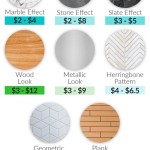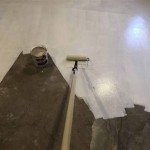Installing Hardwood Flooring Over Concrete: A Comprehensive Guide
Upgrading your flooring with hardwood is an elegant choice that can elevate the ambiance of your home. If you have a concrete subfloor, installing hardwood flooring can be a more involved process but is still achievable with careful planning and execution.
Here's a comprehensive guide to help you navigate the essential aspects of installing hardwood flooring over concrete:
1. Subfloor Preparation
Before laying down the hardwood flooring, it's crucial to have a level and moisture-resistant subfloor made of concrete. To ensure a smooth installation, check for any unevenness or cracks in the concrete and repair them using a self-leveling compound or concrete patcher.
2. Moisture Control
Concrete tends to release moisture, which can damage hardwood flooring. To prevent this, install a vapor barrier between the concrete and the hardwood planks. This will act as a moisture shield and prevent the hardwood from absorbing any excess moisture from the subfloor.
3. Underlayment
Adding an underlayment over the vapor barrier provides additional moisture resistance, sound insulation, and a cushioned layer for the hardwood flooring. Choose an underlayment specifically designed for concrete subfloors, such as foam, cork, or rubber, to enhance the longevity and comfort of your flooring.
4. Expansion Gap
Hardwood flooring expands and contracts with changes in temperature and humidity. To accommodate this natural movement, leave a small expansion gap around the perimeter of the room, between the hardwood planks, and along any fixed objects like walls or cabinets.
5. Installation Methods
There are several methods for installing hardwood flooring over concrete. Glue-down involves bonding the planks directly to the subfloor using a special adhesive. Nail-down requires nailing the planks into a wood underlayment installed over the concrete. Floating installation uses a click-lock system to connect the planks without using glue or nails.
6. Edge Trim
After installing the hardwood flooring, you'll need to add edge trim or molding to cover the expansion gap and protect the edges of the flooring. Choose a molding that complements the hardwood and the overall decor of the room.
7. Finishing Touches
To complete the installation, apply a sealant or finish to the hardwood flooring. This will protect the wood from wear and tear, enhance its natural beauty, and seal any gaps between the planks.
Conclusion
Installing hardwood flooring over concrete can enhance the aesthetics and functionality of your home. By following these essential aspects, you can ensure a durable and beautiful hardwood floor that will add value and enjoyment to your home for years to come.

Installing Wood Flooring Over Concrete Diy

Q A Solid Wood Floors Over Concrete Slabs Jlc

Guide How To Install Hardwoods On A Concrete Subfloor

How Do I Install A Hardwood Floor On Concrete Slab The Carpet Guys

Installing A Hardwood Floor Over Concrete Slab American Information Center

8 Awesome Wood Floor Over Concrete Gallery Solid Hardwood Floors Diy Installation

How To Install A Barn Board Floor Over Concrete Tutorial Diy Passion

Installing Hardwood Floors On Concrete Subfloors

Ask Fred How Do I Install Wood Floor Below Grade Schedule

How To Install Solid Wood Flooring On Concrete And Oak Specialists Suppliers Nexus
See Also







